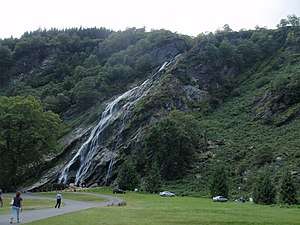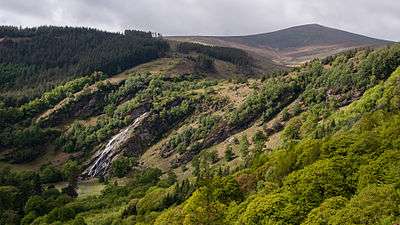Powerscourt Waterfall
Powerscourt Waterfall (Irish: Eas Chonaill),[2] is a 121-metre high waterfall,[1] on the River Dargle near Enniskerry in County Wicklow, Ireland.[3] Situated at the base of the Glensoulan Valley, the waterfall is overlooked by Djouce 725 metres (2,379 ft) and Maulin 570 metres (1,870 ft).[3] The waterfall flows continuously all year, falling in a horsetail-fan, and ranks as the highest waterfall in Ireland.[3] The waterfall is in the Powerscourt Estate, and is open to the public for a visitor fee.[3]
| Powerscourt Waterfall | |
|---|---|
| Eas Chonaill | |
.jpg) Horsetail-fan of the waterfall | |
| Location | Powerscourt Estate, County Wicklow, Ireland |
| Coordinates | 53.146°N 06.211°W |
| Type | Horsetail-fan |
| Total height | 121 metres (397 ft)[1] |
| Number of drops | Cascade waterfall |
| Watercourse | River Dargle |
| World height ranking | 687 |
Geography
Powerscourt Waterfall, known in Irish as Eas Chonaill, lies at the base of the Glensoulan valley, a hanging valley, through which the River Dargle flows from its source on the southern slopes of Tonduff mountain, eventually falling into the steep corrie in which the waterfall lies.[3]
Several mountains surround the upper section of the Glensoulan valley in a "horseshoe-shape", being: Maulin 570 metres (1,870 ft), Tonduff 642 metres (2,106 ft), War Hill 686 metres (2,251 ft), and Djouce 725 metres (2,379 ft).[3] The waterfall is bounded by Crone Woods on its northern section.[3]
Geology
Geological Survey of Ireland (GSI) regard the waterfalls an "important site for both the glacial feature and for the geological influence of the rocks themselves on the formation of the waterfall"; and describe the Powerscourt corrie, in which the waterfall sits, as "a fine example of glacial erosion, where accumulated ice has scoured out a deep basin, with a waterfall flowing down the steep backwall".[4]
The Powerscourt waterfall flows over Irish Ribband Group schists, which sit in a metamorphic aureole of Leinster granite.[4] The cleavage (or schistosity) dips steeply outwards, paralleling the sides of the granite pluton, which forms the surface over which the water cascades; however, the GSI note the contact between schist and granite is some distance upstream of the waterfall.[4]
Both boulders of schist (a silvery-sheen appearance), and of granite (a speckled crystalline appearance), can be seen in the pools at the base of the waterfall.[5]
Access
The waterfall is part of the Powerscourt Estate, who grant paid-access to the public through a separate visitor entrance (6 miles from the main estate entrance) during set times. At the base of the waterfall are visitor facilities, car parking, picnic and barbecue area, and various concessions.[6]
The waterfall can also be viewed from Ride Rock in Crone Woods, which also offers trails to the summit of Maulin.[7][8] A 7-kilometre 3-hour hill-walking route known as the Maulin Circuit, takes in Crone Woods, Maulin and the Powerscourt waterfall.[3]
Notable events
In history
- In August 1821, during the visit of King George IV to Ireland, Richard Wingfield, 5th Viscount Powerscourt dammed the waterfall so he could release a torrent while the two stood on the bridge below the falls. For reasons unknown, the king did not leave the banquet at Powerscourt House to view the waterfall, which was fortunate as, when the water was finally released, the bridge was washed away.[9]
Gallery
_s.jpg) Waterfall in Autumn
Waterfall in Autumn Waterfall and visitor picnic area
Waterfall and visitor picnic area.jpg) Panoramic view of the horsetail-fan shape
Panoramic view of the horsetail-fan shape- From Crone Woods on slopes of Maulin
 Glensoulan Valley and Djouce behind
Glensoulan Valley and Djouce behind
See also
| Wikimedia Commons has media related to Powerscourt Waterfall. |
References
- "Powerscourt Waterfall". World Waterfall Database. Retrieved 14 July 2019.
- "Powerscourt Waterfall". logainm.ie. Irish Placenames Commission. Retrieved 14 July 2019.
- Fairbairn, Helen (2014). Dublin & Wicklow: A Walking Guide. Collins Press. ISBN 978-1848892019.
Route 11: The Maulin Circuit
- "WICKLOW - COUNTY GEOLOGICAL SITE REPORT: Powerscourt Waterfall" (PDF). Geological Survey of Ireland. 2014. Retrieved 14 July 2019.
- "Learn more about the Highest Waterfall in Ireland! Did you know….?". Powerscourt Estate. Retrieved 14 July 2019.
The cliff was formed at the contact point between two different types of rock, granite and mica schist. Look at the boulders and rocks at the base of the waterfall and along the banks of the river – can you pick out the two types? The slatey mica schist, with its silvery sheen is easily distinguished from the whiter, speckled crystalline granite.
- "Powerscourt: Ireland's Highest Waterfall". Powerscourt Estate. Retrieved 14 July 2019.
- Christopher Sommerville (6 June 2009). "Walk of the week: Crone Woods and Maulin Mountain Co Wicklow". Irish Independent. Retrieved 10 July 2019.
- Michael Guilfoyle (30 August 2017). "CRONE WOOD: Walk for the Weekend: A short, simple and safe trail". Irish Times. Retrieved 11 July 2019.
- "Rare items from Powerscourt in Adam's sale". Irish Times. 18 August 2001. Retrieved 14 July 2019.
The intention was that he should also view the famous Powerscourt waterfall, but whether because of lack of time or due to the king becoming incapacitated through excessive consumption of alcohol, this did not happen. It later transpired that a serious accident had been narrowly avoided because Lord Powerscourt had arranged for the water above the fall to be damned so that it might be released while George IV stood on a bridge constructed specially for the occasion. In fact, when the water did come down, the force was so great that the entire bridge was swept away.
- Penny Walker (29 November 2019). "The Irish lough masquerading as a Scandinavian fjord". Daily Telegraph. Retrieved 12 July 2019.
- Neela Debnath (24 January 2018). "Vikings season 5 location: Where is Vikings filmed? Where is it set?". Daily Express. Retrieved 12 July 2019.
Previous filming locations for Vikings include Lough Tay - which is also known as the Guinness Lake due to being owned by the famous family - stands in for Kattegat Village, which is home to Ragnar Lothbrok (played by Travis Fimmel) and his family.
- "Chasing Wicklow's vibrant filming trail". 10 September 2016. Retrieved 12 July 2019.
External links
- Official Website
- Powerscourt Waterfall World Waterfall Database (2019)
- SkyCam View of Powerscourt Waterfall. TheJournal.ie (2014)